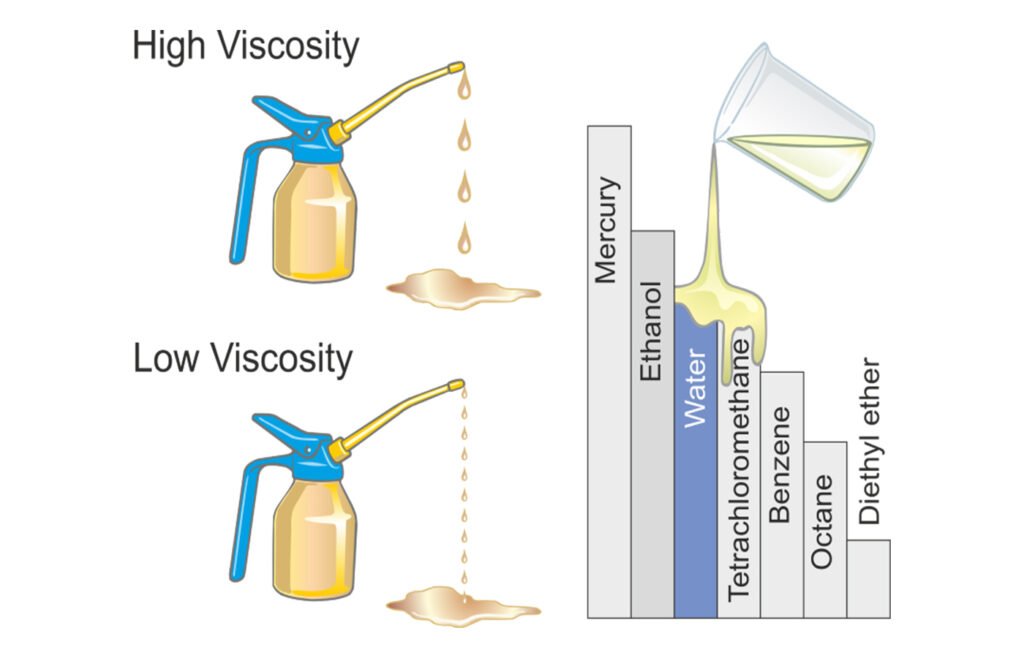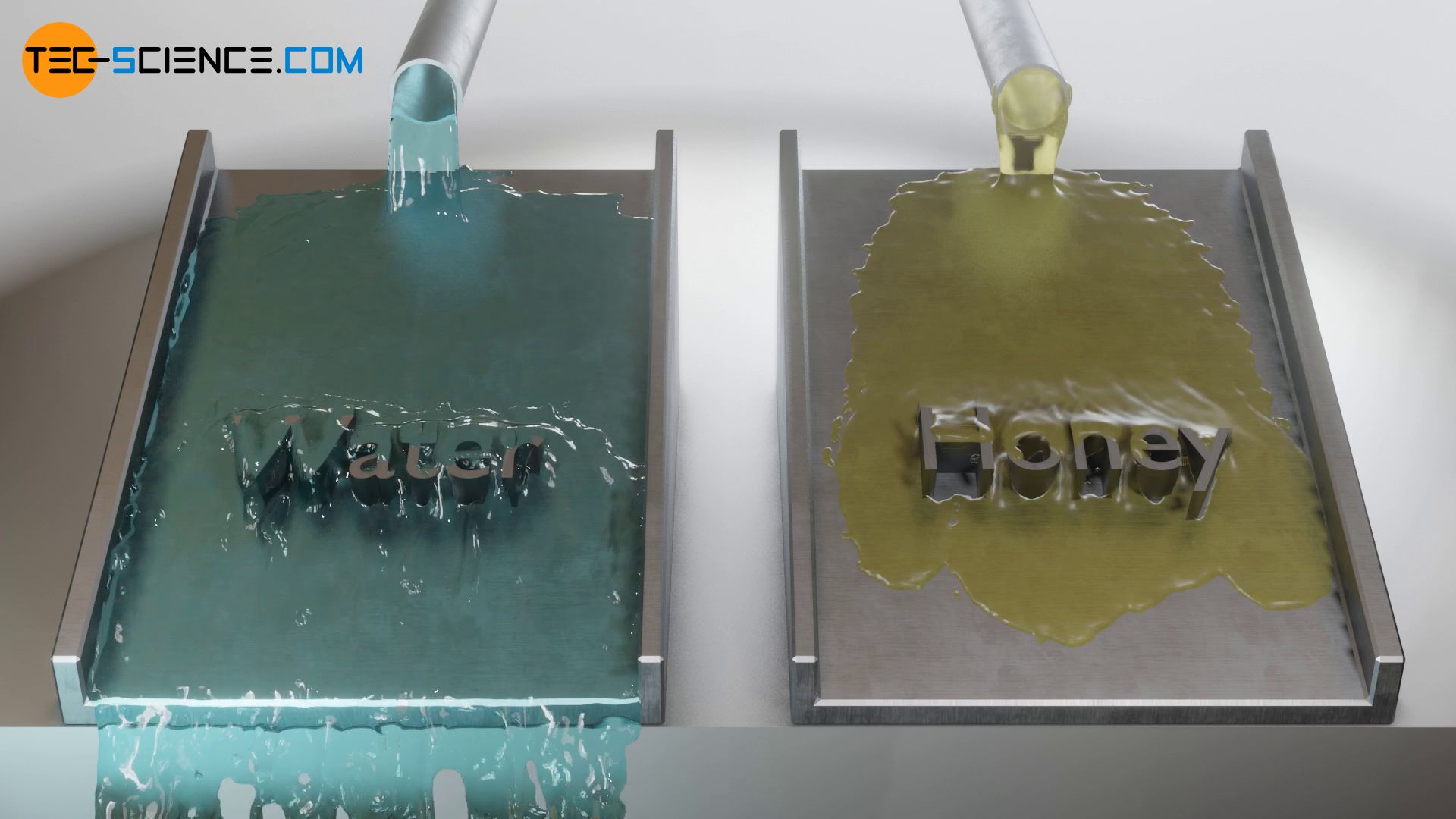Liquids that have a low viscosity have a low resistance to flowing quickly. Examples might include water or rubbing alcohol.The low viscosity of water is important in its role as the solvent for life's chemical reactions and for blood circulation. The viscosity of water has been studied thoroughly because of the precision with which water flow must be controlled in many industrial applications.Viscosity is a measure of a fluid's resistance to flow.
A fluid with low viscosity flows easily because its molecular makeup results in very little friction when it is in motion. Gases also have viscosity, although it is a little harder to notice it in ordinary circumstances.
Which low viscosity liquid is thin and flows easily : Water, milk, and fruit juice all flow very easily; this can be observed when you pour each into a glass. These are all examples of low viscosity or thin liquids. Other examples such as vegetable oil, maple syrup, and dish soap are considerably more viscous, resisting flow and pouring out more slowly.
What viscosity is water
approximately 0.01 poise
The viscosity of water at a temperature of 20 degrees Celsius is approximately 0.01 poise or 10-3 Pa. s (Pascal seconds). Viscosity is a measure of the resistance of a fluid to deformation at a given rate. For liquids such as water, viscosity can be perceived as a measure of the liquid's resistance to flow.
What affects viscosity of water : It has been observed that above about 33° C the viscosity of water increases with pressure, and that below this temperature, initially the pressure effect is negative but at about 1,000 kg/cm2 the viscosity relative to 1 atm.
Liquid water is poured into a Petri dish. Viscosity is the measure of resistance of a fluid to flow. A fluid that is highly viscous has a high resistance (like having more friction) and flows slower than a low-viscosity fluid. To think of viscosity in everyday terms, the easier a fluid moves, the lower the viscosity. 1.0016 mPa.s
The viscosity of water at a temperature of 20 degrees Celsius is roughly equal to 0.01 poise or 10-3 Pa. s (Pascal seconds). Alternately, this value can be represented as 1.0016 mPa. s.
What liquid has the lowest viscosity
The viscosity of a liquid refers to its resistance to flow. The most viscous liquid is typically considered to be honey, while the least viscous liquid is water. Other liquids with high viscosity include molasses, corn syrup, and motor oil, while liquids with low viscosity include ethanol and gasoline.The viscosity of a liquid refers to its resistance to flow. The most viscous liquid is typically considered to be honey, while the least viscous liquid is water. Other liquids with high viscosity include molasses, corn syrup, and motor oil, while liquids with low viscosity include ethanol and gasoline.For simple minds, water has a low viscosity due its small size of its molecules, and a high surface tension due to the strong dipole moment (distance and strength of electric charge). Factors Affecting Viscosity
Temperature: The viscosity of liquids generally decreases as temperature increases.
Pressure: High pressure can increase viscosity, while low pressure can decrease it.
Shear rate: Increasing the shear rate, or the measure of how fast a liquid is being deformed, tends to decrease viscosity.
Why is water less viscous than oil : Vegetable oils are more viscous because they are esters of glycerol, which holds three chains of fatty acids in a 3D branched formation that makes the sliding of molecules past each other rather more difficult than when water molecules do it.
What is viscosity in water : And then look at some examples to make sure it's crystal clear viscosity refers to a substance resistance to flow in essence how fluid it is a substance with a low viscosity will have very little
What has the lowest viscosity
Some of the least viscous liquids include:
Water.
Ethanol.
Acetone.
Methanol.
Isopropyl alcohol.
The viscosity of a liquid is a measure of its resistance to flow. Water, gasoline, and other liquids that flow freely have a low viscosity. Honey, syrup, motor oil, and other liquids that do not flow freely, like those shown in Figure 1, have higher viscosities.Scientifically, the frictional force that acts between the layers of oil particles(viscosity of oil) is greater than the frictional force that acts between the layers of water(viscosity of water). The reason why oil is more slippery than water is due to its lubricity.
What is viscosity of water : The viscosity of water at a temperature of 20 degrees Celsius is roughly equal to 0.01 poise or 10-3 Pa. s (Pascal seconds).
Antwort Why is water low viscosity? Weitere Antworten – Does water have low viscosity
Liquids that have a low viscosity have a low resistance to flowing quickly. Examples might include water or rubbing alcohol.The low viscosity of water is important in its role as the solvent for life's chemical reactions and for blood circulation. The viscosity of water has been studied thoroughly because of the precision with which water flow must be controlled in many industrial applications.Viscosity is a measure of a fluid's resistance to flow.
A fluid with low viscosity flows easily because its molecular makeup results in very little friction when it is in motion. Gases also have viscosity, although it is a little harder to notice it in ordinary circumstances.

Which low viscosity liquid is thin and flows easily : Water, milk, and fruit juice all flow very easily; this can be observed when you pour each into a glass. These are all examples of low viscosity or thin liquids. Other examples such as vegetable oil, maple syrup, and dish soap are considerably more viscous, resisting flow and pouring out more slowly.
What viscosity is water
approximately 0.01 poise
The viscosity of water at a temperature of 20 degrees Celsius is approximately 0.01 poise or 10-3 Pa. s (Pascal seconds). Viscosity is a measure of the resistance of a fluid to deformation at a given rate. For liquids such as water, viscosity can be perceived as a measure of the liquid's resistance to flow.
What affects viscosity of water : It has been observed that above about 33° C the viscosity of water increases with pressure, and that below this temperature, initially the pressure effect is negative but at about 1,000 kg/cm2 the viscosity relative to 1 atm.
Liquid water is poured into a Petri dish. Viscosity is the measure of resistance of a fluid to flow. A fluid that is highly viscous has a high resistance (like having more friction) and flows slower than a low-viscosity fluid. To think of viscosity in everyday terms, the easier a fluid moves, the lower the viscosity.

1.0016 mPa.s
The viscosity of water at a temperature of 20 degrees Celsius is roughly equal to 0.01 poise or 10-3 Pa. s (Pascal seconds). Alternately, this value can be represented as 1.0016 mPa. s.
What liquid has the lowest viscosity
The viscosity of a liquid refers to its resistance to flow. The most viscous liquid is typically considered to be honey, while the least viscous liquid is water. Other liquids with high viscosity include molasses, corn syrup, and motor oil, while liquids with low viscosity include ethanol and gasoline.The viscosity of a liquid refers to its resistance to flow. The most viscous liquid is typically considered to be honey, while the least viscous liquid is water. Other liquids with high viscosity include molasses, corn syrup, and motor oil, while liquids with low viscosity include ethanol and gasoline.For simple minds, water has a low viscosity due its small size of its molecules, and a high surface tension due to the strong dipole moment (distance and strength of electric charge).

Factors Affecting Viscosity
Why is water less viscous than oil : Vegetable oils are more viscous because they are esters of glycerol, which holds three chains of fatty acids in a 3D branched formation that makes the sliding of molecules past each other rather more difficult than when water molecules do it.
What is viscosity in water : And then look at some examples to make sure it's crystal clear viscosity refers to a substance resistance to flow in essence how fluid it is a substance with a low viscosity will have very little
What has the lowest viscosity
Some of the least viscous liquids include:
The viscosity of a liquid is a measure of its resistance to flow. Water, gasoline, and other liquids that flow freely have a low viscosity. Honey, syrup, motor oil, and other liquids that do not flow freely, like those shown in Figure 1, have higher viscosities.Scientifically, the frictional force that acts between the layers of oil particles(viscosity of oil) is greater than the frictional force that acts between the layers of water(viscosity of water). The reason why oil is more slippery than water is due to its lubricity.
What is viscosity of water : The viscosity of water at a temperature of 20 degrees Celsius is roughly equal to 0.01 poise or 10-3 Pa. s (Pascal seconds).